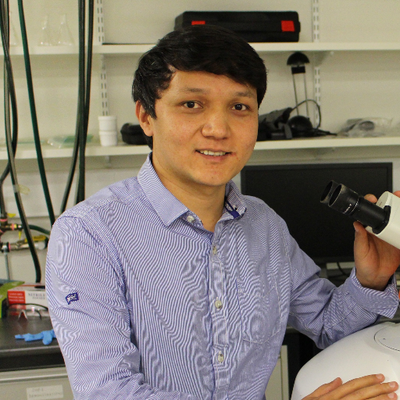Superhydrophobicity: What is it ?
Published:
This is a cross-post of a post I wrote in medium. In this post I try to explain superhydrophobicity in plain langauge.
Have you heard of Neverwet or UltraEverDry? These are commercial coatings that make surfaces extremely repellent to water. You can buy a bottle of Neverwet spray on Amazon for just over $1 per ounce. These coatings can be used on a variety of surfaces including shoes, windows, cars, furniture, walls, and more. To use the products, simply spray them according to the instructions and wait for them to dry.

Photograph of water droplets on leaves of a plant. Photo by Staffan Enbom
The coatings generally come in two parts: a base coating and a top coating. The base coating is a mixture of adhesives and other chemicals, and the top coating is a solution of nanoparticles suspended in a liquid that dries easily. The top coating is the most important and likely the most expensive, while the base coating is simply a layer of adhesive that holds the surface and nanoparticles together. The nanoparticles used are usually made of silica and are modified with hydrophobic molecules, which “hate” water.
When the hydrophobic nanoparticles are sprayed and dried, they form a thin layer that appears smooth to the naked eye but is very rough on a microscopic level. When a droplet of water is placed on the coated surface, only the “hills” of the rough surface come into contact with the water while “pockets” of air are trapped in the “valleys.” The water droplet is supported by the hydrophobic nanoparticles and the “pockets” of air, which water does not like. The air also tries to encircle the droplet.
The water molecule cannot just sit there, so it stands up and tries to rise up. However, gravity takes over and the droplet beads up and tries to fly away. The bead-like shape of water droplets on a superhydrophobic surface is the result of the interaction between various forces. Water droplets on these surfaces are sensitive to even small forces such as wind or gravity that can blow them away or carry them off the surface.
In addition to repelling water, superhydrophobic coatings also repel dust and dirt. Hydrophobic surfaces can be found in nature, such as on the leaves of most plants, butterfly wings, and goose feathers. You may have noticed bead-like droplets on leaves after rain or dew. Superhydrophobic surfaces are the extreme version of hydrophobic surfaces and can also be found in nature, such as on lotus leaves, which inspired scientists and engineers to create artificial ones with practical application potential.
Some easy readings on superhydrophobic surfaces:
Jaroslaw Drelich and Abraham Marmur (2013). “Physics and applications of superhydrophobic and superhydrophilic surfaces and coatings.” Surface Innovations, https://www.icevirtuallibrary.com/doi/full/10.1680/si.13.00017
Laurent Courbin and Howard A. Stone (2007). Your wetting day. Physics Today, https://physicstoday.scitation.org/doi/full/10.1063/1.2711652
Tak-Sing Wong, Taolei Sun, Lin Feng, Joanna Aizenberg (2013). Interfacial materials with special wettability. MRS Bulletin. https://www.cambridge.org/core/journals/mrs-bulletin/article/interfacial-materials-with-special-wettability/D0E7D6EE5FC8930798D0206C87492E8E
